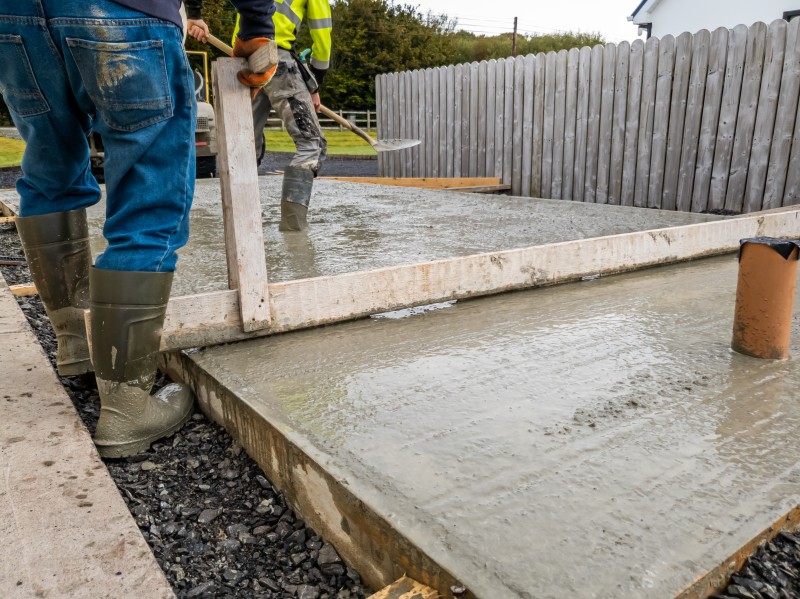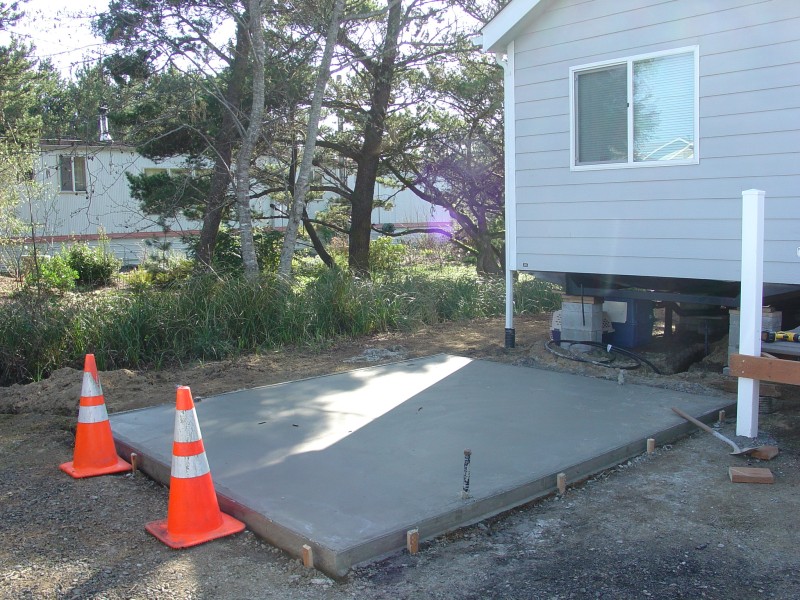If you have trouble imagining a world without concrete, you’re not alone. This invaluable building material has been around – albeit in some very primitive forms – since around 6500 BC when Nabataea traders in Syria and Jordan used a version of concrete for their floors, walls, and cisterns.

When Egyptians built the Great Pyramids of Giza, they employed around 500,000 tons of it and a form of cement even went into building the Great Wall of China.
You’ll still see concrete structures built in Rome circa 3000 BC and by the Middle Ages alchemists had begun to formulate a type of concrete that comes close to the material we use today.
Several people have been credited with inventing this material, including John Smeaton, Joseph Aspdin, Francois Coignet and Louis Vicat.
Each made a significant contribution to the formulation that is now the construction industry’s most frequently-used structural material, so whether your project is big or small, you’ll find it to be essential to the strength and longevity of whatever you intend to build.
In this article we’ll examine and discuss the cost of various concrete slab dimensions such as 24×30, 20×30, 30×30 etc.
A concrete slab is an important structural element in construction projects and is used to create flat surfaces such as floors, ceilings, decks, home foundations etc, so lets see how much it costs in terms of material and labor.
What is the Cost of Concrete Slab per sq ft?
While inflation has recently impacted pricing on everything under the sun, contractors and manufacturers estimate that the national average is around $6.60 per square foot for materials and labor.
Several factors account for the national range in pricing that’s between $4.34 and $8.73 per square foot.
They include slab thickness, concrete type, and the size of the slab. Reinforced and decorative slab finishes are likely to cost you between $9.29 and $10.04 per square foot.
How much does a 24×30 (720 sq ft) Concrete Slab Cost?
As mentioned above, expect to spend an average of $6.60 (a range of $4 to $8 per square foot) for a 24×30-square-foot concrete slab.
Do the math and that brings the total average cost to around $4,700. That stated, taking into consideration factors listed above, the total job could run you between $3,000 and $5,700, once concrete type, thickness and design are factored into the equation.
How much does a 20×30 (600 sq ft) Concrete Slab Cost?
According to experts at HomeGuide.com, the cost of building a 600-square-foot slab will depend largely upon the thickness you need to support the weight of the structure you intend to build.

Opt for 4-inch-thick concrete and expect to spend $5.35 per square foot ($2.83 for materials/$2.52 for labor) which is total of around $3,200.
Make it a 5-inch-thick slab and the per square foot cost comes to $5.76 ($3.20 for materials/$2.56 for labor) which is total of around $3,500.
For a 6-inch-thick slab, you’ll spend $6.17 per square foot ($3.57 for materials/$2.60 for labor) which is total of around $3,700.
The above are only for regular slab without any extra features such as vapor barrier, wire mesh etc which will increase the cost.
How much does a 30×30 (900 sq ft) Concrete Slab Cost?
As with previous estimates, it’s important to have decided the thickness and style of the concrete slab you intend to pour before you arrive at an estimated cost.
That stated, you can rely upon a ballpark figure of between $4 and $8 per square foot slab as quoted earlier, but since size is the determinate factor, an average amount of money to undertake this job is $5,400.
This cost includes wood forms, concrete, fiber meshing, rebar, and labor, but according to the Barndominion Life website, not everyone uses the same quality concrete mix. As a result, your job could cost between $2,547 and $7,200.
How thick should a concrete floor slab be for residential jobs?
Professionals agree that the current standard for residential concrete pours is 4 inches, but if regular or occasional heavy weights like cars, trucks and vans are going to be placed on the concrete slab you’re installing, it’s not unreasonable to request a thickness of 5 or 6 inches.
The concrete product you pick for your project must “meet compressive strength requirements (usually 3,000 pounds per square inch)” according to Pieter Vanderwerf, writing for the Concrete Construction website.
Do you need wire mesh for 4-inch-thick concrete slabs?
Wire mesh products are frequently recommended when pouring concrete slabs of any thickness because while concrete is compression strong, it won’t necessarily withstand tension.
Wire mesh adds flexibility to the concrete slab, so it won’t crack on the underside when subjected to the weight of vehicles, for example.
Can you pour a 4-inch slab without using wire mesh?
The answer is yes if the project in question is a pathway or shed floor that doesn’t need reinforcement to maintain its integrity.
Have in mind though that even concrete sections that won’t be subjected to heavy weights could benefit from wire mesh if the ground beneath the slab is soft and spongy.
In some areas of the country, permits and/or building ordinances stipulate wire mesh for all concrete slab installs.
What is the formula for calculating number of cubic yards in a slab?
As a rule, you can use this formula to calculate the answer:
Length (ft) x Width (ft) x Depth (ft) divided by 27.
Example:
Length: 30 ft
Width: 20 ft
Depth: 4 inch = 0.33 ft
30x20x0.33 = 198 cubic ft / 27 = 7.33 cubic yard.
If you’re a purist who loves to crunch numbers, follow these 6 steps:
- Determine concrete thickness you prefer (e.g 4 inches)
- Measure the length and width you intend to cover
- Multiply the length by the width to ascertain square footage
- Convert thickness figure to feet from inches (e.g 4 inches = 0.33 ft)
- Multiply per-foot thickness by the square footage to find cubic feet
- Convert cubic feet to cubic yards by dividing by 27.
If both formulas leave you scratching your head because math isn’t your strong suit, find an online Calculator which converts cubic ft to cubic yards.
How many bags of concrete do I need for a 10×10 slab?
The thickness of the slab you intend to pour will determine the number of 80-pound bags of concrete you’ll need to do the job, says contractor Mike Day. Save time and effort by using his advice:
- If your goal is a 4-inch-thick slab, you’ll need 56 bags (80-lb bags).
- For a slab that’s 5-inches-thick, up that number to 72 bags (80-lb bags).
- Pour a 6-inch slab and the job will require 84 bags (80-lb bags).
- For an extra-thick 7-inch pour, buy 99 bags.
- Building a skyscraper? Plan on an 8-inch-thick concrete slab and acquire 113 bags to do the job.
How to choose the right concrete for your slab
You might not be among them, but engineers and construction professionals debate about whether ready-mix or site-mix concrete pours are superior, thus engineers making the case for both on the Nearby Engineers website are kind enough to provide comparisons that you may wish to read if you’re offered both options.
Ready-mix concrete
- Ready to use and saves time
- Doesn’t require equipment at the site
- Highly recommended for huge projects
- No storage requirements
- Minimal waste
- Consistent quality
- Labor required only to pour and compact
- Comes in larger batches
- Tends to be more expensive.
Site-mixed concrete
- Requires multiple mixing steps
- Expect longer setting/curing times
- Requires an onsite mixer
- Must be mixed at site to avoid contamination
- Ideal for low-rise projects
- Controlled material storage space required
- Expect spoilage during the mixing process
- Setting/curing times may vary
- Requires more man hours
- Best option for small volume projects.
Related Posts
- 10 Different Types of Glass for Home Windows (With Pros and Cons)
- How to Split a Room by Adding an Interior Wall
- How to Stop Sliding Doors from Rattling – Causes and Solutions
- Cheap Ways to Heat a Room – Efficient and Budget-Friendly Solutions
- 11 Ways to Get Rid of Cooking Smells in a Small Apartment or House
- 11 Stores and Sites Like IKEA For Affordable Furniture and Home Products
Leave a Reply